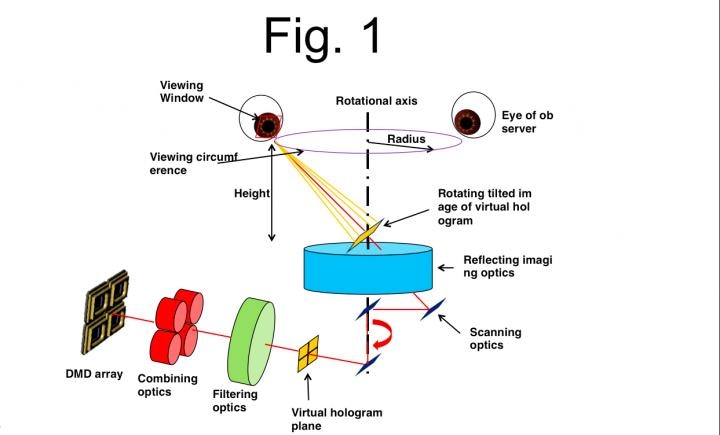Oct 19 2016
Princess Leia, your Star Wars hologram moment may be redeemed. In the original 'Star Wars' movie, the inviting but grainy special effects hologram might soon be a true full-color, full-size holographic image, due to advances by a South Korean research team refining 3-D holographic displays.
 Schematic of the design of 360-degree tabletop electronic holographic display, the design concept of which allows several persons to enjoy the hologram contents simultaneously. (CREDIT: Yongjun Lim, of the 5G Giga Communication Research Laboratory, Electronics and Telecommunications Research Institute, South Korea)
Schematic of the design of 360-degree tabletop electronic holographic display, the design concept of which allows several persons to enjoy the hologram contents simultaneously. (CREDIT: Yongjun Lim, of the 5G Giga Communication Research Laboratory, Electronics and Telecommunications Research Institute, South Korea)
The team described a novel tabletop display system that allows multiple viewers to simultaneously view a hologram showing a full 3-D image as they walk around the tabletop, giving complete 360-degree access. The paper was published this week in the journal Optics Express, from The Optical Society (OSA).
To be commercially feasible in a range of applications -- from medicine to gaming to media -- the hologram challenge is daunting. It involves scaling an electronic device to a size small enough to fit on a table top, while making it robust enough to render immense amounts of data needed to create a full-surround 3-D viewing experience from every angle -- without the need for special glasses or other viewing aids.
"In the past, researchers interested in holographic display systems proposed or focused on methods for overcoming limitations in the combined spatial resolution and speed of commercially available, spatial light modulators. Representative techniques included space-division multiplexing (SDM), time-division multiplexing (TDM) and combination of those two techniques," explained Yongjun Lim, of the 5G Giga Communication Research Laboratory, Electronics and Telecommunications Research Institute, South Korea. Lim and his team took a different approach. They devised and added a novel viewing window design.
To implement such a viewing window design, close attention had to be paid to the optical image system. "With a tabletop display, a viewing window can be created by using a magnified virtual hologram, but the plane of the image is tilted with respect to the rotational axis and is projected using with two parabolic mirrors," Lim explained. "But because the parabolic mirrors do not have an optically-flat surface, visual distortion can result. We needed to solve the visual distortion by designing an aspheric lens."
Lim further noted, "As a result, multiple viewers are able to observe 3.2-inch size holograms from any position around the table without visual distortion."
Building on these advances, Lim's team hopes to implement a key design feature of strategically sizing the viewing window so it is closely related to the effective pixel size of the rotating image of the virtual hologram. Watching through this window, observers' eyes are positioned to accept the holographic image light field because the system tilts the virtual hologram plane relative to the rotational axis. To enhance the viewing experience the team hopes to design a system in which observers can see 3.2-inch holographic 3-D images floating on the surface of the parabolic mirror system at a rate of 20 frames per second.
Test results of the system using a 3-D model and computer-generated holograms were promising -- though right now still in a monochrome green color. Next, the team wants to produce a full-color experience and resolve issues related to undesirable aberration and brightness mismatch among the four digital micromirror devices used in the display.
"We are developing another version of our system to solve those issues and expect to have the next model in the near future, including enhancement of the color expression," said Lim. "Many people expect that high quality holograms will entertain them in the near future because visualizations are increasingly sophisticated and highly imaginative due to the use of computer-aided graphics and recently-developed digital devices that provide augmented or virtual reality."
And the Princess Leia hologram? That old miniature was a motivating experience of their work, Lim explained.